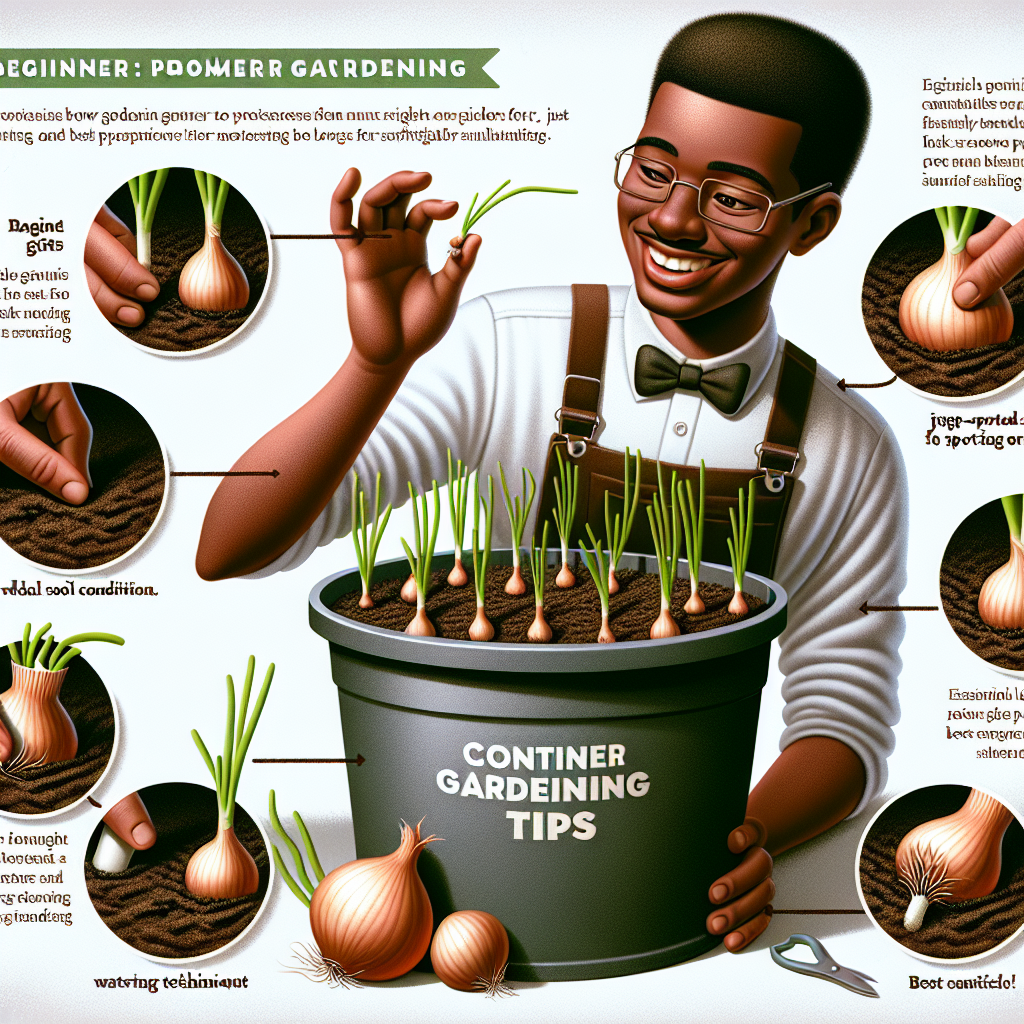Container Gardening for Beginners: Easy Tips for Growing Onions
Container gardening has become a popular way for people with limited space to grow their own vegetables and herbs. One vegetable that is particularly well-suited for container gardening is the onion. Onions are a versatile ingredient that can add flavor to a wide variety of dishes, and they are relatively easy to grow in containers.
If you are new to container gardening and want to try your hand at growing onions, this article will provide you with some easy tips to get started. With a little bit of know-how and some patience, you can enjoy fresh, homegrown onions right from your own balcony or patio.
Choosing the Right Container
When it comes to growing onions in containers, the first step is choosing the right container. Onions have shallow root systems, so they do not require a deep container. A pot that is at least 8 inches deep and has good drainage holes at the bottom is ideal for growing onions.
You can use any type of container for growing onions, including plastic pots, ceramic planters, or even recycled containers such as buckets or old crates. Just be sure that whatever container you choose has adequate drainage and enough space for the onion bulbs to grow.
Selecting the Right Onion Variety
There are many different varieties of onions that you can grow in containers. Some popular choices include green onions (also known as scallions), bulb onions such as yellow or red onions, and sweet onions like Vidalia or Walla Walla. When choosing which variety to grow, consider your personal preferences as well as the climate in which you live.
For beginners, green onions are a good choice because they are easy to grow and mature quickly. Bulb onions take longer to mature but can be harvested all at once when they are ready. Sweet onions tend to have a milder flavor than other varieties and are great for eating raw.
Preparing the Soil
Onions prefer well-draining soil with plenty of organic matter. A good potting mix specifically formulated for vegetables is ideal for growing onions in containers. Alternatively, you can make your own potting mix by combining equal parts of peat moss, perlite, and compost.
Fill your chosen container with the potting mix up to about an inch from the top. Gently press down on the soil to remove any air pockets and create a level surface for planting.
Planting Onions
Onions can be grown from seeds, sets (small bulbs), or transplants (young plants). For beginners, using sets or transplants is often easier than starting from seeds because they require less time and attention.
To plant onion sets or transplants in your container, simply make small holes in the soil about 3 inches apart. Place one set or transplant into each hole and cover them with soil so that only the tops of the sets or transplants are visible above the surface.
Watering and Fertilizing
Onions need consistent moisture throughout their growing season but do not like standing water. Water your onion plants regularly, keeping the soil moist but not soggy. To prevent diseases such as root rot, water only in the morning so that any excess moisture can evaporate during the day.
Fertilize your onion plants every two weeks with a balanced fertilizer high in nitrogen. This will help them grow healthy foliage and form large bulbs.
Growing Onions Indoors vs Outdoors
Onions can be grown both indoors and outdoors in containers. If you live in a location with harsh winters or limited sunlight, growing onions indoors may be a better option for you. Choose a sunny spot near a window where your onion plants will receive at least 6-8 hours of sunlight per day.
If you have outdoor space available, consider placing your onion containers on a balcony or patio where they will receive plenty of sunlight throughout the day. Just be sure to protect them from strong winds by placing them against a wall or using stakes to support them if necessary.
Harvesting Onions
Onion plants typically take 90-120 days to mature depending on the variety you are growing. When their tops start bending over at ground level and turn brownish-yellow in color, it is time to harvest them.
To harvest your onions, gently loosen them from the soil using a trowel or fork being careful not to damage them in any way. Allow them to dry out completely before storing them in a cool, dry place such as a garage or cellar.
Tips for Success
Here are some additional tips that will help ensure success when growing onions in containers:
1. Plant multiple batches : Onions do not store well once harvested so it’s best if you plant multiple batches throughout the growing season rather than all at once.
2.Regularly check moisture level : Always check moisture levels especially during hot summer months as containers tend
3.Give enough room : Make sure there is enough space between each plant so that they have room to grow without being overcrowded.
4.Provide support : As bulb-forming varieties grow taller; provide support such as stakes so that they do not fall over.
5.Watch out for pests: Keep an eye out for pests such as aphids,mites & caterpillars & treat accordingly before an infestation occurs.
Conclusion
Container gardening is an excellent way for beginners to experience the joy of growing their own vegetables right from their own homes.Whether you are interestedin planting green,onions,bulb varieties ortians,youcan easilygrowonionseyenif yon onlyhaveamallspaceto workwith..
If yon followthe tips providedinthis article,raking caretochoose therightcontainerand varie tyofonionto grom,the correctsoil preparationand watering regimen,and providingthemwiththe right amountof sunlightyoncanharvestfresh,onionfromyourcontainergardeninno timeat all.Enjoythe satisfactionof knowingthatyouaregrowingyourownfruits&vegetableseandon’tbeafraidtoexperimentwithdifferentvarieties&growingtechniquesuntilyoufindwhatworkabestfor yon.Happygardening!













